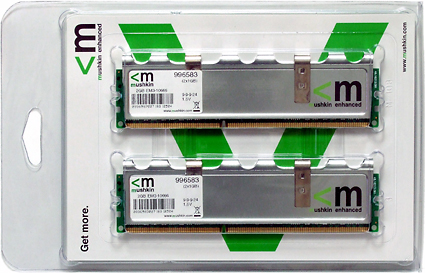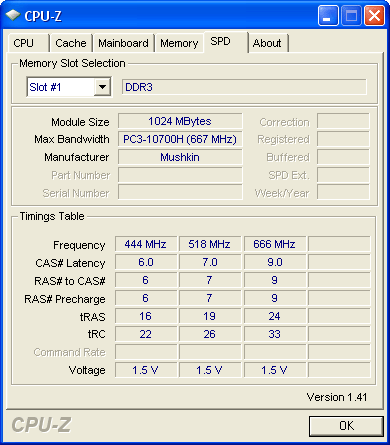DDR3-1333 Speed and Latency Shootout
Mushkin Enhanced EM3-10666
Over the years, Mushkin has shifted marketing focus dramatically from "extreme performance" to "ultimate reliability," yet the company continues to put most of its engineering efforts into high-speed parts. And what more could an enthusiast want besides speed and reliability?
Unlike many of Mushkin's previous efforts, its part number 996583 2 x1 GB dual-channel kit is rated at rather mundane DDR3-1333 timings of 9-9-9-24, using a motherboard's DDR3 default voltage of 1.50V. This is also the memory's DDR3-1333 SPD value, so builders will find the memory's rated performance simply by installing it into an FSB-1333 processor system.
Other SPD values include 444 MHz and 518 MHz, which are interpreted in BIOS to DDR3-800 and DDR3-1000 values. Again, a wider range of users would probably find a DDR3-1066 value more beneficial than the oddball DDR3-1036, as systems that default to DDR3-1066 will instead use the slower DDR3-1333 SPD timings.
Current page: Mushkin Enhanced EM3-10666
Prev Page Kingston HyperX PC3-11000 Next Page OCZ PC3-10666 Platinum EditionGet Tom's Hardware's best news and in-depth reviews, straight to your inbox.
-
dv8silencer I have a question: on your page 3 where you discuss the memory myth you do some calculations:Reply
"Because cycle time is the inverse of clock speed (1/2 of DDR data rates), the DDR-333 reference clock cycled every six nanoseconds, DDR2-667 every three nanoseconds and DDR3-1333 every 1.5 nanoseconds. Latency is measured in clock cycles, and two 6ns cycles occur in the same time as four 3ns cycles or eight 1.5ns cycles. If you still have your doubts, do the math!"
Based off of the cycle-based latencies of the DDR-333 (CAS 2), DDR2-667 (CAS 4), and DDR3-1333 (CAS8), and their frequences, you come to the conclusion that each of the memory types will retrieve memory in the same amount of time. The higher CAS's are offset by the frequences of the higher technologies so that even though the DDR2 and DDR3 take more cycles, they also go through more cycles per unit time than DDR. How is it then, that DDR2 and DDR3 technologies are "better" and provide more bandwidth if they provide data in the same amount of time? I do not know much about the technical details of how RAM works, and I have always had this question in mind.
Thanks -
Latency = How fast you can get to the "goodies"Reply
Bandwidth = Rate at which you can get the "goodies" -
So, I have OCZ memory I can run stable atReply
7-7-6-24-2t at 1333Mhz or
9-9-9-24-2t at 1600Mhz
This is FSB at 1600Mhz unlinked. Is there a method to calculate the best setting without running hours of benchmarks? -
Sorry dude but you are underestimating the ReapearX modules,Reply
however hard I want to see what temperatures were other modules at
a voltage of ~ 2.1v, does not mean that the platinum series is not performant but I saw a ReapearX which tended easy to 1.9v(EVP)940Mhz, that means nearly a DDR 1900, which is something, but in chapter of stability/temperature in hours of functioning, ReapearX beats them all. -
All SDRAM (including DDR variants) works more or less the same, they are divided in banks, banks are divided in rows, and rows contain the data (as columns).Reply
First you issue a command to open a row (this is your latency), then in a row you can access any data you want at the rate of 1 datum per cycle with latency depending on pipelining.
So for instance if you want to read 1 datum at address 0 it will take your CAS lat + 1 cycle.
So for instance if you want to read 8 datums at address 0 it will take your CAS lat + 8 cycle.
Since CPUs like to fill their cache lines with the next data that will probably be accessed they always read more than what you wanted anyway, so the extra throughput provided by higher clock speed helps.
But if the CPU stalls waiting for RAM it is the latency that matters.


